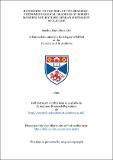Returning to the 'soil of the sensible' : phenomenological readings of Robert Morris's and Richard Serra's minimalist sculpture
Abstract
This assessment of the Minimalist sculpture of artists Robert Morris and Richard Serra endeavours not only to describe the ways in which Maurice Merleau-Ponty's phenomenological philosophy has been utilised to analyse the formal character of their work, but also to question the extent to which critical interpretations of such artworks may lay claim to their intended meaning. Firstly, Merleau-Ponty's significant text, the Phenomenology of Perception, will be introduced by exploring a number of its themes relating to perception and to how the body acts as a locus for human experience within the phenomenal world. Secondly, it will be shown how notable comments taken from the Phenomenology have been discussed in relation to several of Robert Morris's Minimalist artworks made between 1962 and 1969. Next, additional ideas taken from the Phenomenology will be brought to bear on the Minimalist sculpture of Richard Serra whose artworks and writings from between 1966 and 1980 have also been interpreted, like those of Morris, to be products of a general phenomenological 'sensibility'. Yet as part of the conclusion to this thesis, the contemporary, critical reception of Morris's and Serra's works will be discussed and particularly, the problematic ways in which Merleau-Ponty's phenomenological theory has been used by commentators to 'explain' several of the non-traditional aspects of their practice. This ultimately serves to bring into question the applicability of such theory to these artists' production. Firstly, we will inspect what evidence is provided by Morris's and Serra's artworks and writings which would support their connection with Pontean theory. Secondly, we will look at just how critics cite Merleau-Ponty's text as a source for Minimalist practice. At the end of such analyses, we may be better able to assess whether the rigorous interpretation of many of these artists' works by way of the Phenomenology is justified, or whether this critical trend is a misapplication of a complex philosophical theory to an equally complex and multivalent form of art practice.
Type
Thesis, MPhil Master of Philosophy
Collections
Items in the St Andrews Research Repository are protected by copyright, with all rights reserved, unless otherwise indicated.

